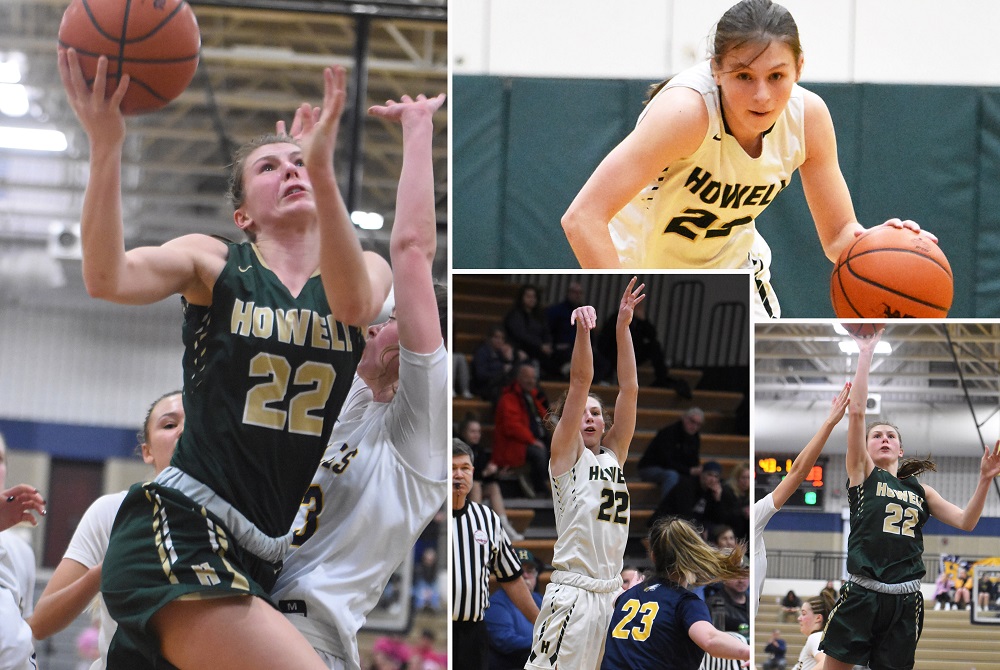
St. John's Potent All-Around Game Includes Abilities To Direct, Dazzle
By
Tim Robinson
Special for MHSAA.com
February 25, 2022
HOWELL — Maeve St. John is, as an opposing coach described her, “the straw that stirs the drink” on the Howell girls basketball team.
 And, at first glance, the evidence backs that assertion.
And, at first glance, the evidence backs that assertion.
She is the team’s captain, leading scorer, one of its top rebounders, the school record-holder for assists and she also paces the Highlanders in charges taken, steals and blocked shots.
But, she said, her teammates keep her in line and focused, and that has made the difference in a Howell team that has beaten Division 1 powers Hartland and Wayne Memorial this season, with a possible rematch with Hartland in next week’s District tournament.
The difference?
“I accept criticism a lot better,” St. John says. “Last year, I was definitely more hard-headed. I feel I’m taking so much more advice from my teammates, and they hold me much more accountable. They can help me be better.”
What she’s been good at this season is helping her teammates be better, finding an open teammate, which in turn opens up more shots for herself.
Asked if she prefers scoring to feeding her teammates, St. John is quick with an answer.
“Assists are way better,” she said. “It's fun watching your teammates score, going in and getting a bucket and hitting shots. That’s exciting.”
St. John is averaging 15 points per game, with a robust 7.2 assists per contest and nearly three steals per as well.
“She’s better at harnessing her energy, and not feeling she has to be the one who does it all,” Howell coach Tim Olszewski said. “Maybe it’s an increased trust in her teammates, but she’s understanding that if she can draw an extra defender to her, then one of her teammates is open.”
St. John also occasionally makes a flashy move for no other reason than she can, sometimes looking over at the Howell bench with a smirk on her face.
“If you’re not trying to have fun out there, you’re not going to have fun,” she said. “I’m always looking to have fun out there. I’m always competing, trying new moves. Sometimes, they work. Sometimes they don’t, and I’m on the bench. Either way, it’s fun to try new things, to see what you’re capable of.”
That keeps opposing coaches, and her teammates, on alert, especially when St. John sees an opening and whips the ball to a teammate that may or may not be anticipating the pass.
“That happens a lot,” teammate Molly Duerloo said, chuckling. “But we capitalize on that. Her (on-court) vision has become better.”
Make no mistake about it: St. John has that rare combination of talent, curiosity, and joy one doesn’t often see in a top player.
“Boy, can she play this game,” Olszewski said. “She’s one of those special, special players. She just is. I don’t know how else to say it. She’s got the ability and the head about herself, and it’s going to be wonderful to watch her for four years at Northwood, because I think she’s going to excel there.”
Brighton coach Paul Ash, after watching her in a game in mid-February, also was impressed.
“I love watching that kid,” he said. “I’d pay money to watch that kid play. She’s a real, real competitor. She’s a fun kid to watch.”
St. John has little regret when it comes to sending up long-distance shots (she routinely launches 3-point tries from well beyond the arc), but also has no qualms about driving the lane or going after rebounds.
“She just plays at a high level,” Hartland coach Don Palmer said. “She’s exciting, she’s aggressive, and those kids just follow along,”
In addition to leading her team in most statistical categories, she also works closely with teammates in practice and even during games.
“She holds everyone accountable in practice,” Duerloo said. “She pushes everyone to be the best player they can be. She picks me up during a game if I’m not going good. She’ll say, ‘Hey you’ve got this. Next play. Believe in yourself.’”
The support, St. John said, goes both ways.
“They hold me accountable,” she said. “There are definitely some looks, some cussing out, ‘Hey, let’s go.’ That kind of thing. It’s a mutual respect. I think this group is something special. We’re all so close. We have all these inside jokes. Bus rides are fun. We feel so confident when we’re with each other.
“My teammates fuel me,” she added. “You look at someone going 110 percent, if you’re telling them to do something and you’re only going 80 percent, you’re not going to get any respect or anything done.”
St. John has signed with Northwood University, where she is considering majoring in personal finance or sports management.
“I love a lot of business-related things,” she said.
Right now, her increased understanding of her role as point guard and the possibilities it presents is a key reason why the Highlanders have won 14 of their last 15 games after a 1-3 start.
“She’s understanding the bigger picture,” Olszewski said. “There’s a reason why that particular shot or action, even though it might seem small or trite right now, how it could have a massive effect on the outcome of a game. And I think she’s excelled in that this year, understanding those situations.”
And, he said, St. John has been much more communicative with her teammates in helping them understand.
“Maeve’s always had an excellent basketball IQ and could always read situations,” Olszewski said. “When we talk about her being a leader, it’s about calming things down as opposed to throwing kerosene on the fire. I’ve also noticed an increase in her keeping herself accountable. Many times this year, she’s said, ‘That’s on me, team.’ She’s stepped to the forefront, which is what leaders do. She’s done a great job harnessing that energy and knowing when to unleash it and when to bring it back in a little bit.”
For St. John, it’s not so much being the straw that stirs the drink as being the leader of a pack of Highlanders willing to follow her for as long as possible.
But not without a little whimsy. Late in that mid-February game against Brighton, she drove the lane into a group of Bulldogs and somehow drew a foul on a shot that was off the mark. As she emerged, she looked at Olszewski and grinned.
“It was a forced shot, more like, ‘Oooh I got lucky on that play,’” she said. “I felt like I got bailed out on that play, and I looked at him and we chuckled.”
Howell had the game well in hand at that point. What if the game had been close?
“He wouldn't have been smiling,” St. John said, then added with a grin, “I probably would have still done it.”
PHOTOS Howell’s Maeve St. John has shown she can do it all – drive to the basket, shoot from the perimeter and find the open teammate. (Photos by Dan Zeppa.)
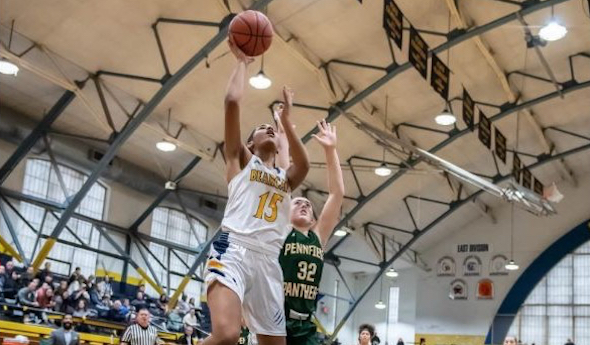
Hoops Finds Annual Home During Holidays
December 27, 2019
By Ron Pesch
Special for Second Half
Nothing says the Holidays like a high school basketball tournament.
It started, like many things do, with a drip. Well, make that a dribble.
The Michigan High School Athletic Association has allowed Holiday basketball tournaments for years. When was the first? That’s hard to establish. No one really kept track of such. A 1934 Wakefield News article indicates that a “Christmas Tournament will be held for the (Gogebic) Range teams at Wakefield December 27 and at Ironwood December 28.” Hurley, Bessemer, Ironwood and Wakefield were entered in the “blind” tournament, with opponents drawn just before game time. It was a new idea, at least in the Upper Peninsula.
“Nothing of its kind has ever been attempted in the Peninsula before,” stated the Ironwood Daily Globe. The tournament, won by Hurley, was a financial success. After expenditures, including the purchase of trophies, profit equaled enough that $22.42 was distributed to each school competing in the tournament. Plans were announced to bring back the tournament in a larger format the following year. It did return the following December, with the same teams in the same format but with all games played in Wakefield. This time out, Ironwood topped Hurley 22-21 for the tournament title.
In the Lower Peninsula in 1935, an All-Berrien County Holiday tournament was held Dec. 26, 27 and 28, with Three Oaks winning the Class B-C division title, 15-13 in the final over Berrien Springs. St. Joseph Catholic emerged as the Class D victor with a surprising 27-26 win over the reigning MHSAA state champ from Stevensville. The 14-team competition was played at Niles High School. Attendance was “slim, very slim” for the opening day of the tourney. The event did not return in 1936.
A similar, but much smaller, event was staged in Berrien County in 1941 with the Bridgman Class C Invitational. The tournament featured seven teams with contests spread over three nights. It was a success.
“Some 450 paid admissions were checked in Wednesday night for the championship finals, which Bridgman won from Berrien Springs. … The total paid admission for the three night event was 1,420 fans with a gross gate of approximately $400.”
By the mid-1940s, the idea of playing prep basketball during the Christmas lull had begun to take off across the state.
In December 1946, before a crowd of 1,500 at the Flint IMA Auditorium, Holland, the reigning Class A champion, downed Flint Northern 51-48 behind a pair of late field goals by Ken ‘Fuzz’ Bauman in the first annual Motor City Invitational. In Jackson, Detroit Catholic Central won the Michigan Catholic Invitational, beating Kalamazoo St. Augustine, 42-40. Bridgman again snagged the title at the Sixth Annual Berrien Class C Christmas Holiday Tournament. It was the Bees’ third Christmas championship in four years. The Little Eight Conference Holiday Tournament was played across four school gymnasiums as the calendar transitioned from 1946 to 1947. Bangor downed Covert, 34-29, in the championship contest hosted at Watervliet High School on Saturday, Jan. 4.
“Holiday tournament basketball has really caught on in Michigan,” said Hal Schram in the Detroit Free Press in 1947. “There will be no Christmas-New Year’s rest for at least 60 Michigan high school squads which have jumped at the chance to sharpen their collective shooting eyes for the long season ahead. … At last count, tournaments will be played between Dec 17 and Jan 3 at Flint, Saginaw, Grand Rapids, Jackson, Lincoln Park, Fremont, Negaunee, Marquette, Benton Harbor and Detroit.”
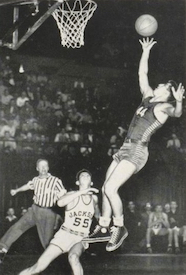 The same eight schools that played at the first Motor City tournament – Jackson, Grand Rapids Central, Holland, Muskegon Heights, Monroe, Midland, Flint Central and Flint Northern – were invited back for the second year. According to Schram, “Not a single participating school of a year ago wanted to be left out.”
The same eight schools that played at the first Motor City tournament – Jackson, Grand Rapids Central, Holland, Muskegon Heights, Monroe, Midland, Flint Central and Flint Northern – were invited back for the second year. According to Schram, “Not a single participating school of a year ago wanted to be left out.”
Jackson downed Flint Northern in the title game, 39-34.
The Saginaw Invitational, hosted at Arthur Hill High School, boasted six Class A schools as well as Alma and Mount Pleasant, both Class B schools. Mount Pleasant surprised the field, winning the tournament with a 40-25 triumph over Dearborn Fordson in the championship game.
A year later in December, Schram wrote, “The Michigan High School Athletic Association wasn’t caught unaware when the tournament bug started to bite every sector of the state.”
“Never did we expect such a wave of tournament play as we will see during the next three weeks,” said Charles Forsythe, state director for the MHSAA, noting 34 Christmas vacation tournaments were scheduled between December 15 and January 8 during the 1948-49 basketball season. “Perhaps we’re lucky at that. The Oklahoma association has had to sanction 123 tournaments.”
Forsythe and Schram explained the reasons for the wave of popularity. Of particular interest was the fact that, at the time, a school sponsoring both football and basketball could play a total of no more than 24 games, combined, in the two sports. However, MHSAA rules allowed a basketball team the chance to play as many as three games during a Holiday tournament and be charged with only one of its allotted combination of 24 contests. (The MHSAA rules changed prior to 1972-73 to allow basketball teams a maximum of 20 games.)
Coaches could keep their squads sharp during the two-week layoff with games rather than just mandatory practices. And, as a bonus to all because tournaments were financed through gate admissions, invitations to larger tournaments meant teams got to “stay and eat at the best hostelries, go on sightseeing tours when not playing and play non-conference opponents from other sections of the state.“
Add in the chance to play before larger-than-normal crowds, and the formula for a successful tournament was cast.
Beginning with the 1950-51 season, the football-basketball rule was altered to count play in mid-season invitational tournaments as two contests. With the change, according to the Detroit Times, “the number of such meets dropped sharply.”
Only nine Holiday tournaments, involving 50-plus teams, were recorded by the MHSAA during the 1951-52 season: the 5th annual Flint Parochial Invitational, the Alpena Catholic Invitational (involving 16 teams), the 5th Annual Greater Lansing Invitational, the Albion College Invitational, the Twin-Five Conference Christmas Tournament (a 10-team replacement for the disbanded Little Eight Conference’s tournament), the Otisville Invitational, the Columbiaville Invitational and the 1st Annual Portland St. Patrick Christmas Invitational.
But by the 1960s, Holiday Tournaments were again regaining popularity, with more now focused on teams from a specific community or section of the state, especially among smaller schools.
The St. Patrick tournament was still going strong in 1966 – its 15th year – with an eight-team, four-day design. Williamston downed a Cinderella squad from Carson City, 64-44, before 1,100 fans at Portland to earn the championship. Other Mid-Michigan holiday tournaments played out in Chelsea and Swartz Creek at the same time.
The Flint Parochial League Tournament was a mainstay of the Holiday season until the breakup of the league in the early 1970s.
“Basketball tournaments have become popular around the state and nation in recent years,” wrote Wendy Foltz, longtime Battle Creek Enquirer sports editor, before the kickoff of the inaugural Battle Creek Central Holiday Cage Tournament in 1968. In a twist that harkened back to earlier days, the eight-team event represented nearly every section of lower Michigan. “Battle Creek never has been a rabid basketball town like some around the state,” added a hesitant Foltz, noting a hope that the event could at least break even.
Hosted at the Cereal City’s historic Fieldhouse, built in 1928, that first tournament was won by host Battle Creek Central, which downed Traverse City 71-53 before a crowd of 2,000. Phil Todd led the Bearcats with 29 points, including 21 in the first half, while 6-foot-8 Tom Kozelko paced TC with 24. Muskegon Heights won the consolation game, holding off a late Ypsilanti Willow Run rally, 78-77. Other schools competing were Battle Creek Lakeview, Grand Blanc, Romulus and recently-opened Jackson Lumen Christi.
Chuck Turner, Central’s head coach, and junior varsity coach Jack Schils had contacted 60 schools during the summer of 1967 to organize the 12-game schedule.
“The response was terrific,” said Schils, who added, “Many schools could not accept because of schedule commitments but want to enter a year hence.”
The Battle Creek tournament was back in 1969, again hosting teams from near and far. Schils noted that cost ran high when teams were brought in from long distances: “However, this type of tournament is highly desirable so we hope fans will support it.”
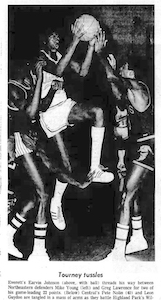
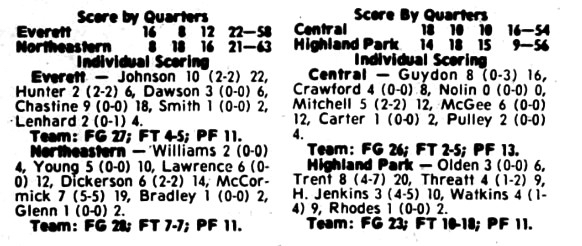 But the event was discontinued following the 1970-71 season when the “eight team format became too unwieldy,” according to the Enquirer “… and both crowd and the quality of play declined.”
But the event was discontinued following the 1970-71 season when the “eight team format became too unwieldy,” according to the Enquirer “… and both crowd and the quality of play declined.”
Pared down to a four-team format, it returned in a big way in December 1975. The tournament saw standing-room-only crowds of more than 3,000 for games between Battle Creek Central, Detroit Northeastern, Class A quarterfinalist Lansing Everett and reigning Class A champion Highland Park.
Detroit Northeastern downed Lansing Everett, 63-58 for the Cereal City championship trophy. Everett junior Earvin Johnson scored 22 points and, with teammate Reggie Chastine, was named to the all-tournament team along with Northwestern’s Wilbert McCormick, the tourney MVP, and his teammate Greg Lawrence. Highland Park’s William Trent and Battle Creek Central’s Leon Guydon also were named to the team.
By the 1980s, it seemed that the Christmas break nearly mimicked March in Michigan.
“I think a Christmas tournament really helps your program,” said Turner in 1980 to the Enquirer. He had taken over the head coaching position at Battle Creek in the fall of 1967 after a successful stint at Willow Run. “I don’t understand basketball teams having a preseason, playing three or four games, then taking two weeks off. When you get back, it’s like starting over.”
Besides Turner’s squad, the 1980 field included Detroit Western, Detroit Murray Wright and eventual winner Kalamazoo Central. The event would ultimately be re-christened the Battle Creek Central Chuck Turner Holiday Classic.
“The late Chuck Turner started bringing big games to the city over the holidays when he first started at the school in the 1960s,” wrote Bill Broderick in the Enquirer in 2018.
“Chuck started this because he wanted to give people the chance to come back home for the holidays and see everyone play. It’s been like a family reunion over the years,” Fred Jones told Broderick. Jones was a longtime assistant to Turner. “That we can keep it going in his name is great and hopefully we can keep if going for another 50 years.”
The girls are now part of the action. All five Battle Creek city schools – Central, Pennfield, Harper Creek, Lakeview, and St. Philip – were part of the event in 2018.
This year the Chuck Turner Central Field House Holiday Classic will again span two days – December 27 and 28 – and will again see all five city schools play on the historic floor.
Other Holiday tournaments scheduled this year include:
Petoskey Invitational – December 13-14
Raider Shootout – December 21
18th Annual Muskegon Area Sports Hall of Fame Classic – December 27
Earl McKee Classic – December 27-28
North Farmington Holiday Extravaganza – December 27
Motor City Roundball Classic – December 27
Cornerstone Invitational – December 27
Washtenaw Hoops Showcase – December 28
 Ron Pesch has taken an active role in researching the history of MHSAA events since 1985 and began writing for MHSAA Finals programs in 1986, adding additional features and "flashbacks" in 1992. He inherited the title of MHSAA historian from the late Dick Kishpaugh following the 1993-94 school year, and resides in Muskegon. Contact him at [email protected] with ideas for historical articles.
Ron Pesch has taken an active role in researching the history of MHSAA events since 1985 and began writing for MHSAA Finals programs in 1986, adding additional features and "flashbacks" in 1992. He inherited the title of MHSAA historian from the late Dick Kishpaugh following the 1993-94 school year, and resides in Muskegon. Contact him at [email protected] with ideas for historical articles.
PHOTOS: (Top) The Battle Creek Central and Pennfield girls face off during the 50th Chuck Turner Classic. (Middle) Shaheen Shaheen scores two points for Flint Northern, which fell to Jackson 39-34 during the 1947 Motor City championship game. (Below left) Lansing Everett’s Earvin Johnson makes a move toward the basket against Detroit Northeastern during the 1975 Battle Creek event. (Below right) Box scores from the 1975 tournament include Johnson’s 22 points in the 63-58 loss. Photos courtesy of the Battle Creek Enquirer, Lansing State Journal and Ron Pesch archives.)

